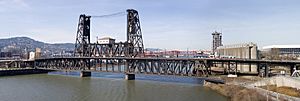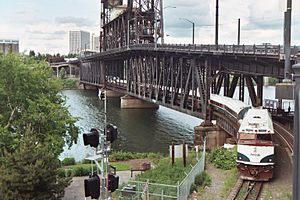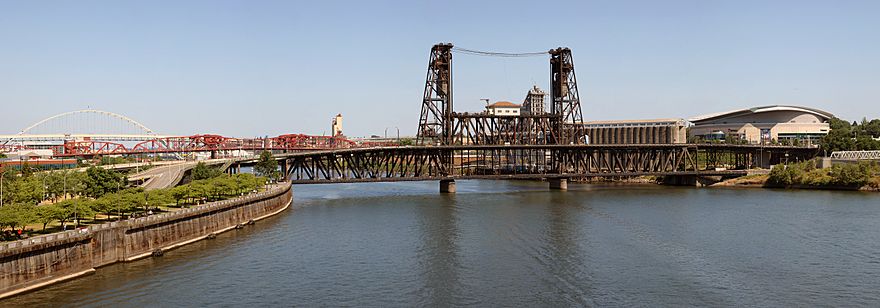Steel Bridge facts for kids
Quick facts for kids Steel Bridge |
|
|---|---|
 |
|
| Coordinates | 45°31′40″N 122°40′04″W / 45.5277°N 122.6677°W |
| Carries | Upper: 2 outer lanes for general traffic, 2 inner lanes solely for MAX Light Rail, and sidewalks on both sides Lower: Union Pacific Railroad (incl. Amtrak toward Eugene) and walkway |
| Crosses | Willamette River |
| Locale | Portland, Oregon |
| Owner | Union Pacific Railroad |
| Maintained by | Union Pacific Railroad |
| Characteristics | |
| Design | Through truss with a double vertical-lift span |
| Width | 71 feet (22 m) |
| Longest span | 211 feet (64 m) |
| Clearance below | 26 feet (7.9 m) closed 72 feet (22 m) lower deck raised 163 feet (50 m) fully raised |
| History | |
| Opened | 1912 (replaced 1888 bridge) |
The Steel Bridge is a special kind of bridge in Portland, Oregon, United States. It's a "double-deck" bridge, meaning it has two levels, and it can lift both of them! It crosses the Willamette River and first opened in 1912.
The lower deck is for trains, bikes, and people walking. The upper deck is for cars, buses, and the city's light rail system called MAX Light Rail. This makes it one of the busiest and most "multimodal" bridges in the world, meaning it carries many different types of transportation.
What makes the Steel Bridge truly unique is that it's the only double-deck bridge in the world where both decks can lift up independently. It's also the second oldest bridge of its kind in North America. This amazing bridge connects the Rose Quarter and Lloyd District on the east side of Portland to the Old Town Chinatown neighborhood on the west side.
Contents
History of the Steel Bridge
The Steel Bridge we see today was finished in 1912. It replaced an older bridge, also called the Steel Bridge, which was built in 1888. The first Steel Bridge was a "swing-span bridge," meaning it would swing open to let boats pass. It was the very first railroad bridge to cross the Willamette River in Portland.
The original bridge got its name because it was built using steel, which was a new and unusual material for bridges back then. When the current bridge was built, it simply kept the famous name.
Building the Bridge
The engineering company Waddell & Harrington designed the Steel Bridge. They had offices in both Kansas City, Missouri, and Portland. The Union Pacific Railroad and the Oregon-Washington Railroad and Navigation Company worked together to build it. The project cost about $1.7 million at the time.
The bridge opened for trains in July 1912. Cars started using it a little later, on August 9, 1912.
Early Travel on the Bridge
The first Steel Bridge (from 1888) was used by horse-drawn streetcars. Then, in 1889, Portland's first electric streetcars started crossing it. When the new Steel Bridge opened in 1912, the electric streetcar lines moved over to it. Streetcars continued to use the bridge until 1948.
Later, in 1986, electric trains returned to the bridge when the MAX Light Rail system began using it.
Changes Over the Years
In 1950, the Steel Bridge became an important part of a new highway route, U.S. 99W.
In the mid-1980s, the bridge got a big upgrade that cost $10 million. This project included building the tracks for the new MAX light rail line. The bridge was closed for two years, from 1984 to 1986, for this work. It reopened in May 1986, and the MAX light rail service started in September of that year.
The lower deck of the bridge has faced threats from major floods over the years, including in 1948, 1964, and 1996.
In 2001, a new walkway was added to the southern side of the bridge's lower deck. This walkway is 220-foot-long (67 m) and 8-foot-wide (2.4 m). It's part of the Eastbank Esplanade, a popular path along the river. Now, there are three ways for people to walk across the bridge: this new lower walkway and the two narrow sidewalks on the upper deck.

In 2000, about 23,100 vehicles, 200 MAX trains, 40 freight and Amtrak trains, and 500 bicycles crossed the bridge every day. After the new lower-deck walkway opened, bicycle traffic jumped to over 2,100 crossings daily by 2005! MAX train traffic has also grown a lot, with over 600 trips crossing the bridge on weekdays as of 2012. This is because three more MAX lines (Red, Yellow, and Green) now use the bridge, in addition to the original Blue Line.
In 2008, the upper deck was closed for three weeks. Workers built a new connection for the MAX tracks on the west side. After this, the two inner lanes on the upper deck became only for MAX trains. Cars, buses, and other vehicles could only use the two outer lanes.
In 2012, the Steel Bridge celebrated its 100th birthday! The Oregonian newspaper called it the "hardest-working" bridge on the Willamette River because it carries so much: "Cars, trucks, freight trains, buses, Amtrak, MAX, pedestrians, bicycles — you carry it all."
How the Steel Bridge Works
The part of the bridge that lifts up is 211 feet (64 m) long. When the river is low, the bottom deck is 26 feet (7.9 m) above the water. When both decks are fully raised, there's 163 feet (50 m) of space underneath for tall boats to pass.
Because each deck can lift on its own, the lower deck can be raised 72 feet (22 m). It actually slides up into the upper deck without disturbing it! Each deck has its own heavy counterweights to help it lift. The upper deck has two, and the lower deck has eight. Together, these counterweights weigh a massive 9 million pounds (about 4,100 metric tons)!
The machinery that makes the bridge lift is located in a house on top of the upper deck's lift structure. The bridge operator sits in a room hanging below the machinery house. This way, they can see both the river traffic and the upper deck. After the lower-deck walkway was added in 2001, cameras and TV screens were installed so the operator could also see people on the lower deck.
Before the bridge was renovated in the 1980s, two "gate tenders" had to manually swing gates across the road and sidewalks to stop traffic when the bridge lifted. Now, these gates are powered and controlled automatically by the bridge operator.
Sister Bridge
The Steel Bridge has a "sister bridge" that opened one year earlier, in 1911. This is the ASB Bridge in Kansas City, Missouri. Like the Steel Bridge, the ASB Bridge once carried cars, trains, and streetcars. However, in 1987, a new bridge was built for cars, and the road deck on the ASB Bridge was permanently closed and removed. Now, the ASB Bridge only carries trains for BNSF.
Images for kids






